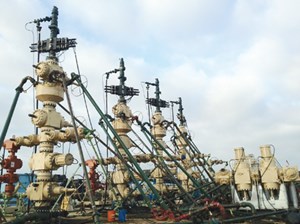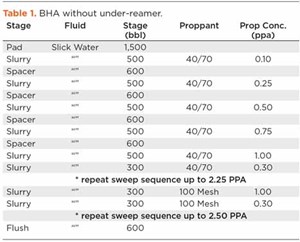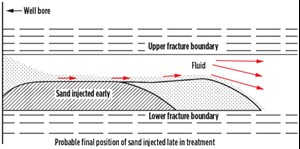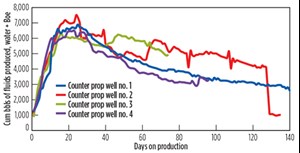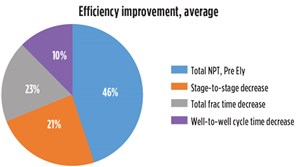Hydraulic fracturing–A view from 50,000 feet
The landscape of today’s oil and gas business is vastly different from what was once considered standard in our industry. Gone are the dominant days of single, vertical well completions where it was not common place for operations to break for the day once the planned stage had been completed or the sun had set on the horizon. High viscosity fracturing fluids were once pre-mixed on location and loads of specialized proppant were delivered and inspected for the job to come. There was a time when the number of reputable pressure pumping service companies available for the work could be counted with a few fingers, each with a fancy catalog of chemicals and products to fit your every completion need. Even the pulse of the market was taken by analyzing the number of active rigs in the running, along with the price of West Texas Intermediate. That was the past.
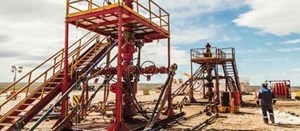
Today, still riding the wave of the shale boom, horizontal wells are being permitted and drilled at breakneck speeds. Operators are continually pushing the envelope on lateral lengths, and optimizing the days between spud and release of rigs. Zipper fracturing operations have brought wellsite efficiencies to all new levels. Multiple wells on a single pad site are now commonplace; where it is not unusual to find up to fifteen wellheads staring you in the face when you pull up to location for that early morning safety brief, Fig.1.
A direct supply chain of fracturing materials and products like proppant, chemicals and equipment are now available to the operator directly, bypassing the service companies in many cases. There are now many more pressure pumping service companies and chemical vendors available today than there was 10 or 15 years ago, opening the arena for more competitive bidding. Large, slick water fracturing operations dominate the scene, proving more economical and optimal in plays and fields where gelled and crosslinked fluids were both used in the past. An enormous inventory of drilled but uncompleted wells (DUCs) litter all the major oil and gas plays of North America, with the most found in West Texas, while the number of active drilling rigs has fallen to 2009–2010 levels and no longer serve as an indicator of basin-wide activity.
WHAT’S WORKING AND WHY?
This is the single most asked question we at Ely & Associates are bombarded with during our interactions with familiar faces and new friends in the office conference room or over a meeting at lunch. We often refer to ourselves as the “50,000 foot people,” because we are involved with several completions programs spread across dozens of operators who work in multiple plays, both domestically and overseas.
Our answer is fairly simple: “Slick water. Lots and lots of slick water.” We firmly believe that in order to effectively and optimally stimulate a nano-Darcy rock, a very large network of complex fractures and cracks must be created and then propped open for any meaningful volume of hydrocarbons to be produced over the life of the well.
It is also important that this is completed utilizing slurry pump rates in excess of 80 bpm or greater to place these large volume fracture treatments. One of the most common mistakes we often see from pumping schedules is the shear lack of initial pad volume, before the introduction of proppant.
Fundamentally speaking, this is the most critical portion of any unconventional fracturing job, since it is during this pad volume that the fracture geometry is established, and the network of fracture complexity is first created. Pumping a short pad volume is almost a certain recipe for a lackluster and very inefficient slick water frac, given the lack of effective stimulated surface area and the ultra-low permeability of the tight oil and gas reservoir.
We advocate and recommend large slick water pad volumes for unconventional fracturing designs. Pumping these large volumes of thin, non-viscous fluids, at high slurry pump rates, will create the required surface area and complexity to eventually produce from these shale plays. To optimize pad volumes, we recommend formation evaluation tests (FETs) be conducted at least once on stages one or two and with lithological or permeability changes throughout the lateral, utilizing solid plugs to allow for additional diagnostic stages.
The proppant used and how it is placed is equally important as the fluid that transports it down the well and through the perforations. We know that small mesh proppants work and are certainly applicable in unconventional operations, with little to no crush observed. Small sized, they are easily transported with low viscous fluids, such as slick water, and have the ability to be placed further out and disperse in the extended facture network than the heavier larger mesh proppants. It is because they can be placed further out in the wellbore, that a proppant concentration greater than what can be easily transported via slick water is excessive, and frankly, unnecessary.
Our belief is that conductivity is achieved by propping open cracks that are infinitely conductive. None of the large volume “hybrid-treatments” achieves effective proppant concentrations of more than 0.50 psf. At less than 0.50 psf, one would expect virtually zero proppant conductivity, yet we have wells producing greater than 5,000 bpd from these nano-Darcy rocks. Most operators are unaware that the proppant pack conductivities for proppants promoted in the industry are for 2.00 to 6.00 psf. We have not seen any high-rate, unconventional proppant fracture treatments come even remotely close to this level of proppant placement, thus reinforcing our belief that overall well production is not a result of a proppant pack created during the hydraulic fracturing process, but rather that of sand placed and left to prop open the created fractures.
Recent articles in broadly accepted, industry-wide publications, have illustrated to us how proppant is found distributed throughout the fracture network, without crushing or embedment, with grains of the proppant within the cracks and fissures created by hydraulically fracturing an unconventional reservoir such as the Wolfcamp in West Texas1. With trace signs of slight proppant packing only found around the near wellbore area from the cored samples, one must believe that the proppant placed during these slick water treatments are simply acting to prop and hold open cracks, creating an infinitely conductive pathway for hydrocarbon migration. And, it appears to be yielding favorable results, with no indications of the industry deviating away from these low viscosity fracture fluids or small mesh sands.
Our recent successes with what we dub CounterProp has also turned a few heads and sparked some newfound interest. Simply put, we recommend pumping and placing the larger mesh sands first, and then tailing in with the smaller meshes to finish off the treatment, Table 1.
This means pumping 40/70 sand first, followed by 100 mesh, with our belief that whatever is pumped first will be closest to the wellbore. A 40-year-old diagram demonstrating how sand settles further illustrates this notion, Fig. 2. This very old illustration still holds true today.
Our belief has been validated time and time again by significant increases in short- and long-term production. By pumping the larger mesh proppant first, you are creating the conductivity at the wellbore, as well as bridging off and diverting. This allows for the smaller mesh sands to be placed beyond the wellbore and into the far-reaching fracture network of complex fracs and cracks. Results from projects in the Rockies and a more recent treatment in the Permian for Operator A have validated our CounterProp method and approach to stimulating better-producing wells, Fig. 3. This particular well, like several others for the customer, was flowed up the production casing for over four months, before artificial lift was installed, and sustained a large volume of cumulative fluid (barrels of oil and water) for months, before requiring the installation of tubing and a lift pump.
We have also been heavily advocating and incorporating on-site diagnostics to be performed prior to the first stage on a well. Often confused with a diagnostic fracture injection test (DFIT) or mini-frac pump in, a fluid efficiency test (FET) is conducted prior to the main treatment, valuable information such as fracture closure pressure, fluid efficiency, recommended pad percentage and pad volumes can be ascertained from a simple five minute pump-in at constant rate. A DFIT is often time consuming and conducted at low rates, before shutting down and observing pressure decline for almost a week’s time.
When performed correctly, the information from an FET has helped identify the ideal pad volume required, allowing for the overall pump schedule to be modified accordingly. This has been helpful in avoiding any net pressure gain throughout slick water treatments, which can be detrimental and lead to near wellbore bridging and premature screen out. These FETs have been regularly pumped ahead of conventional crosslink treatments but are very much applicable in everyday unconventional applications.
It is important to keep in mind that although slick water treatments can be optimized via onsite diagnostics, some shale plays do not react well to pump-in tests. FETs require no special equipment or any measurable amount of non-pumping time (NPT), which makes them that more attractive to implement on projects. These simple diagnostics do require that the personnel carrying out the procedure and interpreting the resulting data be competent and skilled in order to truly optimize the treatment for the customer.
TIME-WORN TENDENCIES AND PRACTICES
We also sometimes find ourselves face-to-face with the occasional “hybrid” fracture design, sprinkled with large mesh sands placed at high concentrations in some of the more popular shale basins. Somehow, these high-rate cocktails of slick water, linear and crosslinked fluids have secured a niche in our current industry, regardless of how contrary they may be in their nature and application.
Thick, viscous fluids have the tendency to create dominant fractures that act to inhibit the potential for maximizing fracture surface area and complexity in shales. The recent popularity of high viscous friction reducers (HVFR), a polyacrylamide concoction first used in the late 50s to early 60s, offers both the elements of friction reduction and proppant transporting viscosity, as well as helping reduce tortuosity when applied correctly.
Where possible, we steer clear from viscosity because of how complexity is hindered and sacrificed by the viscous fluid. When applied appropriately, HVFR agents can prove to be quite valuable on a frac location, with the relative cost of a single gallon of the chemical less than traditional guar based linear gel. Linear, crosslinked gels and high viscosity friction reducers have their place in our industry; however, being pumped as primary fracturing fluids for ultra-low permeability reservoirs is not one of them.
The need for high viscosity fluids is driven in part by the requirement to place both small and large mesh proppants at concentrations exceeding what can be transported safely via water and friction reducer alone; and to achieve that elusive single planar proppant pack at the end of a treatment. Again, any measureable amount of conductivity with these sands would require enormous volumes of proppant to be placed at a consistent concentration exceeding the carrying abilities of commonly found, mixed-on-the-fly, high friction reducer-based fluid systems. Only perfect proppant transporting fluids have the ability to allow for piston-like displacement and are and precisely metered with carefully planned and executed onsite quality control.
Ideally, these treatments are also flowed back immediately following the final shut down to force-close the fracture. These types of treatments are still performed in higher permeability reservoirs but are extremely rare. Not only are these treatments very expensive, field experience has shown they do not work as well as slick water treatments in nano-Darcy rock. We have also found that the initial pad volumes for many treatments are questionably low and are not adequate in creating the required surface area for any meaningful production in unconventional applications. When we hear that these timeworn tendencies make pretty good wells, we often ask if they would like to make better, more cost-effective ones.
We also see that many times a well perforation plan has more than the required perforations. By excessively perforating more holes than can be stimulated by the design fracture treatment, one cannot effectively treat, and produce, an acceptable percentage of them. Treating each perforation at a minimum 2 bpm can help ensure that a large amount, if not all, of the perforations are receiving fluid during the main treatment. This effectively presents in the range of 600 to 1,000 psi of perforation friction pressure. Someone with a fundamental understanding of friction pressures may be able to correlate whether or not a suitable amount of holes are open or not.
By perforating too few holes, injection rates in the excess of 3 to 4 bpm per perf, have the potential to jet and eat away at the perforations themselves. The unnecessary excess fracturing pressures throughout the treatments may also prove to be costly, in part to service company pricing structures and extra friction reducer costs. Ely & Associates advocates the limited-entry technique on virtually every frac design we help optimize and would caution against over perforating, as well as extreme limited entry techniques.
THINK VERTICALLY AND THINK BIG
Ely & Associates has been optimizing and executing high rate, low viscosity slick water treatments in both unconventional and conventional reservoirs alike for years. Our in-house optimization process has been applied to traditionally conventionally-completed plays such as those found in the Frio, Yeso, Clear Fork, Tubb, San Andrus, Uintah basin, and many others with successful results. Somewhat surprisingly to many, past vertical completions utilizing large, high rate slick water treatments have also been met with success. We believe that in order to effectively treat and stimulate a vertical well, one must think larger than the typical frac job found in a lateral. Given the understandable lack of wellbore and potential contact with the reservoir to stimulate, the fracture treatments themselves must be large enough to create the complex surface area required to produce.
It is irrational to consider that comparative production can be achieved on a vertical well with a similar sized job versus a single, horizontal treatment stage. It is because of this rational that we recommend single, vertical treatments in the excess of 40,000 to 50,000 bbl per stage along with a proppant volume close to that of one million total pounds. The actual size of these jobs will vary on the gross and net pay of the interval and available wellbore to partition the desired intervals. We have been instrumental in preparing and executing many large, high rate slick water treatments in the past, and continue to advocate their legitimacy and effectiveness today.
PROVEN RESULTS
Current market conditions have driven completions techniques to be more efficient and to reduce overall completion’s costs associated with the well-to-well cycle time. Achieving higher benchmark production results with CAPEX discipline has driven innovation that we have been able to partner with our clients as a part of the success of their programs.
In addition to design optimization capabilities, metrics on improving efficiencies can also be achieved with strong operational support. In a recent case study, we were tasked with a full metrics analysis regarding operational time stamps on nonproductive time (NPT) along with metrics from key performance indicators (KPI). It should be noted that we partnered with our client for onsite supervision and holding all variables of their completions program as a constant for accurate NPT and KPI analysis. Completing a two-month study for a dedicated stimulation program yielded some interesting takeaways, Fig. 4.
- 73% of the total NPT time was attributed to frac operations (pre Ely)
- Total stage to stage time was reduced by 33% (frac, wireline, prep, greasing, etc.)
- Total frac time was reduced by 36% (pumping preexisting frac design with no changes)
- Total well-to-well cycle time was reduced by 16% (rig down, mobilization, rig up, and all other essential operations)
The results were compelling in building and justifying the case that having the right experience on location can be paramount within the completion’s program. It is also a team initiative in that it allowed for a more cohesive environment for all levels of talent to flourish within their areas of expertise. The metrics also proved that no matter how efficient a program may seem, or how repetitive the processes in place may be, there was room for improvements that translate to achieving increased levels of quantifiable success, which includes increased recoverable reserves. In summary, success can be defined in many categories pertaining to a client’s specific program. Design and well production optimization can be achieved along with improved operational efficiencies and does not have to be a segregated process or split stream direction of which achievements to target. WO
REFERENCES
(Rassenfoss, Stephen. 2018. A look into what fractures really look like. Journal of Petroleum
Technology, November: 23–36)
- Shale technology: Bayesian variable pressure decline-curve analysis for shale gas wells (March 2024)
- U.S. oil and natural gas production hits record highs (February 2024)
- When electric meets intelligence: Powering a new era in hydraulic fracturing (January 2024)
- Next-generation electric fracturing system improves efficiency, ESG performance (January 2024)
- Going global with unconventionals (December 2023)
- Singlet oxygen-generating treatment technology achieves sustainable operations, helps operators meet production goals (November 2023)

